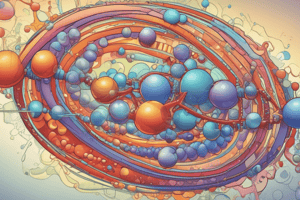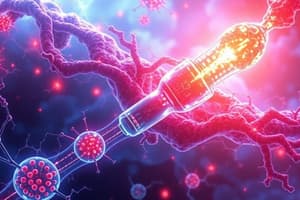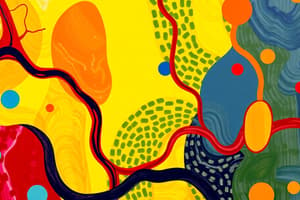Podcast
Questions and Answers
What is the primary effect of insulin in the body?
What is the primary effect of insulin in the body?
- Increasing lipolysis
- Promoting glycogenesis (correct)
- Enhancing protein breakdown
- Stimulating gluconeogenesis
What condition is characterized by mutations in the INSR gene?
What condition is characterized by mutations in the INSR gene?
- Rabson-Mendenhall syndrome (correct)
- Cushing's Syndrome
- Diabetes Mellitus
- Type 2 Diabetes
Which hormone primarily acts as the body's hypoglycemic agent?
Which hormone primarily acts as the body's hypoglycemic agent?
- Epinephrine
- Insulin (correct)
- Cortisol
- Glucagon
Which of the following hormones is NOT classified as a hyperglycemic agent?
Which of the following hormones is NOT classified as a hyperglycemic agent?
What is the main role of glucagon in glucose metabolism?
What is the main role of glucagon in glucose metabolism?
What happens to glucagon levels in diabetes mellitus due to insulin deficiency?
What happens to glucagon levels in diabetes mellitus due to insulin deficiency?
Which process does insulin inhibit in the body?
Which process does insulin inhibit in the body?
What are the expected metabolic responses during fasting conditions?
What are the expected metabolic responses during fasting conditions?
What is a common symptom of diabetes mellitus?
What is a common symptom of diabetes mellitus?
Which pathway is NOT primarily associated with glucose metabolism?
Which pathway is NOT primarily associated with glucose metabolism?
What component is NOT included in the metabolic syndrome cluster?
What component is NOT included in the metabolic syndrome cluster?
What is the primary function of glucose in the body?
What is the primary function of glucose in the body?
What significant risk does diabetes increase in affected individuals?
What significant risk does diabetes increase in affected individuals?
Insulin signaling is initiated through which action?
Insulin signaling is initiated through which action?
Which condition is NOT a consequence of high glucose levels?
Which condition is NOT a consequence of high glucose levels?
What change in the insulin signaling pathway contributes to insulin resistance?
What change in the insulin signaling pathway contributes to insulin resistance?
Which of the following is NOT correlated with the occurrence of Type 2 Diabetes (T2D)?
Which of the following is NOT correlated with the occurrence of Type 2 Diabetes (T2D)?
What is a common cause of secondary diabetes?
What is a common cause of secondary diabetes?
What immediate effect does a carbohydrate-rich meal have on insulin and glucagon levels?
What immediate effect does a carbohydrate-rich meal have on insulin and glucagon levels?
Impaired Glucose Tolerance (IGT) is most accurately described as:
Impaired Glucose Tolerance (IGT) is most accurately described as:
What happens in the normal individual during postabsorptive (fasting) state?
What happens in the normal individual during postabsorptive (fasting) state?
Gestational Diabetes (GD) occurs:
Gestational Diabetes (GD) occurs:
What is the role of gluconeogenesis in glucose metabolism?
What is the role of gluconeogenesis in glucose metabolism?
What characterizes the fasting state in diabetic individuals?
What characterizes the fasting state in diabetic individuals?
Which complication of diabetes occurs more frequently in Type 1 Diabetes than in Type 2 Diabetes?
Which complication of diabetes occurs more frequently in Type 1 Diabetes than in Type 2 Diabetes?
What is a major cause of Type 1 diabetes?
What is a major cause of Type 1 diabetes?
Which of the following is characteristic of abnormal lipid levels in Type 2 Diabetes?
Which of the following is characteristic of abnormal lipid levels in Type 2 Diabetes?
In which situation does ketoacid formation primarily occur?
In which situation does ketoacid formation primarily occur?
In which age group is Type 2 diabetes primarily observed?
In which age group is Type 2 diabetes primarily observed?
What factor leads to the increased need for insulin secretion during pregnancy?
What factor leads to the increased need for insulin secretion during pregnancy?
What happens to blood glucose levels after a meal in nondiabetic individuals?
What happens to blood glucose levels after a meal in nondiabetic individuals?
What effect does insulin deficiency have on the body during fasting?
What effect does insulin deficiency have on the body during fasting?
What blood glucose level is indicative of Hyperglycemic Hyperosmolar Nonketotic Coma?
What blood glucose level is indicative of Hyperglycemic Hyperosmolar Nonketotic Coma?
What is the typical starting glucose level at which symptoms of hypoglycemia appear?
What is the typical starting glucose level at which symptoms of hypoglycemia appear?
What is the recommended carbohydrate load for the postprandial plasma glucose test?
What is the recommended carbohydrate load for the postprandial plasma glucose test?
For diagnosing diabetes, what glucose level is suggestive after two consecutive postprandial tests?
For diagnosing diabetes, what glucose level is suggestive after two consecutive postprandial tests?
What dietary condition is required before conducting an Oral Glucose Tolerance Test?
What dietary condition is required before conducting an Oral Glucose Tolerance Test?
What is the fasting condition before an Oral Glucose Tolerance Test?
What is the fasting condition before an Oral Glucose Tolerance Test?
What does a glucose value of greater than or equal to 200 mg/dL indicate after 2 hours in an Oral Glucose Tolerance Test?
What does a glucose value of greater than or equal to 200 mg/dL indicate after 2 hours in an Oral Glucose Tolerance Test?
How do healthy subjects typically respond to the Oral Glucose Tolerance Test compared to diabetic individuals?
How do healthy subjects typically respond to the Oral Glucose Tolerance Test compared to diabetic individuals?
What is the response of a person with Type 1 Diabetes (T1D) to a glucose load?
What is the response of a person with Type 1 Diabetes (T1D) to a glucose load?
What is the recommended method for the detection of Diabetes Mellitus (DM) according to ADA?
What is the recommended method for the detection of Diabetes Mellitus (DM) according to ADA?
At what blood glucose level is diabetes diagnosed using a Random Plasma Glucose Test?
At what blood glucose level is diabetes diagnosed using a Random Plasma Glucose Test?
What level of HbA1c indicates a diagnosis of diabetes mellitus?
What level of HbA1c indicates a diagnosis of diabetes mellitus?
Which condition is associated with microalbuminuria?
Which condition is associated with microalbuminuria?
What does HbA1c represent in terms of blood glucose levels?
What does HbA1c represent in terms of blood glucose levels?
Why is urinary glucose considered a poor marker for Diabetes Mellitus (DM)?
Why is urinary glucose considered a poor marker for Diabetes Mellitus (DM)?
What is the primary pathophysiological mechanism of diabetes as indicated by insulin resistance?
What is the primary pathophysiological mechanism of diabetes as indicated by insulin resistance?
Flashcards
Metabolic Syndrome
Metabolic Syndrome
A cluster of metabolic factors found in individuals who are prone to cardiovascular disease, diabetes, and stroke, characterized by insulin resistance, abdominal obesity, dyslipidemia, hypertension, pro-thrombotic state, and inflammation.
Diabetes Mellitus (DM)
Diabetes Mellitus (DM)
A condition where the body cannot properly regulate glucose metabolism, leading to high blood sugar levels. This can cause a variety of symptoms, including frequent urination, excessive thirst, constant hunger, and unexplained weight loss.
Glycolysis
Glycolysis
The process where glucose is broken down into pyruvate, yielding ATP and NADH. It's the first step in glucose metabolism that occurs in the cytoplasm.
Tricarboxylic Acid Cycle (TCA)
Tricarboxylic Acid Cycle (TCA)
Signup and view all the flashcards
Glycogenesis
Glycogenesis
Signup and view all the flashcards
Glycogenolysis
Glycogenolysis
Signup and view all the flashcards
Gluconeogenesis
Gluconeogenesis
Signup and view all the flashcards
Insulin Signalling Pathway
Insulin Signalling Pathway
Signup and view all the flashcards
Hyperglycemia
Hyperglycemia
Signup and view all the flashcards
Rabson-Mendenhall syndrome
Rabson-Mendenhall syndrome
Signup and view all the flashcards
Catabolic metabolism
Catabolic metabolism
Signup and view all the flashcards
Anabolic metabolism
Anabolic metabolism
Signup and view all the flashcards
Insulin
Insulin
Signup and view all the flashcards
Glucagon
Glucagon
Signup and view all the flashcards
Cortisol
Cortisol
Signup and view all the flashcards
Glucose Homeostasis
Glucose Homeostasis
Signup and view all the flashcards
Post-absorptive State
Post-absorptive State
Signup and view all the flashcards
Fatty Acid Utilization
Fatty Acid Utilization
Signup and view all the flashcards
Meal-Induced Glucose Response
Meal-Induced Glucose Response
Signup and view all the flashcards
Diabetes and Glucose Metabolism
Diabetes and Glucose Metabolism
Signup and view all the flashcards
Type 1 Diabetes
Type 1 Diabetes
Signup and view all the flashcards
Type 2 Diabetes
Type 2 Diabetes
Signup and view all the flashcards
Diabetic Fasting State
Diabetic Fasting State
Signup and view all the flashcards
Hyperglycemic Hyperosmolar Nonketotic Coma (HHNS)
Hyperglycemic Hyperosmolar Nonketotic Coma (HHNS)
Signup and view all the flashcards
Postprandial Plasma Glucose Test
Postprandial Plasma Glucose Test
Signup and view all the flashcards
Oral Glucose Tolerance Test (OGTT)
Oral Glucose Tolerance Test (OGTT)
Signup and view all the flashcards
OGTT Standard Conditions
OGTT Standard Conditions
Signup and view all the flashcards
OGTT Threshold for Diabetes
OGTT Threshold for Diabetes
Signup and view all the flashcards
OGTT Curve Interpretation
OGTT Curve Interpretation
Signup and view all the flashcards
T2D Characteristics
T2D Characteristics
Signup and view all the flashcards
Secondary Diabetes
Secondary Diabetes
Signup and view all the flashcards
Impaired Glucose Tolerance (IGT)
Impaired Glucose Tolerance (IGT)
Signup and view all the flashcards
Gestational Diabetes (GD)
Gestational Diabetes (GD)
Signup and view all the flashcards
Causes of Gestational Diabetes
Causes of Gestational Diabetes
Signup and view all the flashcards
Complications of Diabetes
Complications of Diabetes
Signup and view all the flashcards
Hyperlipidemia in Diabetes
Hyperlipidemia in Diabetes
Signup and view all the flashcards
Diabetic Ketoacidosis
Diabetic Ketoacidosis
Signup and view all the flashcards
Plasma Insulin Response to Glucose Load
Plasma Insulin Response to Glucose Load
Signup and view all the flashcards
Fasting Blood Glucose Test
Fasting Blood Glucose Test
Signup and view all the flashcards
Random Plasma Glucose Test
Random Plasma Glucose Test
Signup and view all the flashcards
Glycated Hemoglobin (HbA1c)
Glycated Hemoglobin (HbA1c)
Signup and view all the flashcards
Microalbuminuria
Microalbuminuria
Signup and view all the flashcards
Insulin Resistance
Insulin Resistance
Signup and view all the flashcards
Study Notes
Carbohydrate Metabolism Disorders & Diabetes
- Diabetes is a chronic metabolic disease, characterized by elevated blood glucose levels.
- Type 2 diabetes is prevalent in adults, typically caused by insulin resistance or insufficient insulin production.
- Type 1 diabetes occurs when the pancreas produces little to no insulin.
- Access to affordable treatment, including insulin, is crucial for people with diabetes.
- Approximately 422 million people globally have diabetes, primarily in low- and middle-income countries.
- The number of diabetes cases and prevalence have increased steadily in recent decades.
Health Implications of Diabetes
- Direct effects and long-term complications, including coronary heart disease and cerebrovascular disease/stroke.
- Individuals with diabetes have a two-fold greater risk of myocardial infarction.
Metabolic Syndrome
- Metabolic syndrome is a cluster of metabolic factors (insulin resistance, glucose intolerance, obesity, dyslipidemia, hypertension, thromboembolic state, and inflammation) increasing cardiovascular disease risk.
- Obesity, weight gain, especially in the abdominal region, are important factors.
Common Symptoms of Diabetes Mellitus (DM)
- High blood and urine glucose levels (hyperglycemia and glucosuria).
- Frequent urination (polyuria).
- Excessive thirst (polydipsia).
- Increased hunger (polyphagia).
- Sudden weight loss.
- Elevated blood and urinary ketones (ketonemia and ketonuria) during acute episodes.
Glucose Metabolism Regulation
- Hormonal regulation of glucose metabolism focuses on storing glucose as glycogen and mobilizing stored glucose to maintain blood glucose levels.
- Glucose is important for the brain and other tissues as a primary energy source.
- In response to low blood glucose (e.g., fasting), hyperglycemic agents act on stored macromolecules to create glucose.
- Proteins are broken down for glucose production (gluconeogenesis) in the liver.
Anabolic and Catabolic Hormones
- Glucagon, epinephrine, cortisol, thyroxine, growth hormone, and some intestinal hormones are critical hyperglycemic agents.
- Insulin promotes anabolic (building) processes, while these other hormones induce catabolic (breaking down) processes.
Insulin Signaling Pathways
- Insulin signals through its cell-surface receptor, triggering a cascade of events: phosphorylations, second messengers, and protein-protein interactions.
- Insulin signaling pathways affect diverse metabolic processes across most tissues.
- Genetic variations and protein molecule changes in the insulin signal transduction pathway can lead to insulin resistance.
Insulin Signaling Defects
- Mutations in the INSR gene associated with Rabson-Mendenhall syndrome reduce the number or affect the function of insulin receptors on cell membranes, compromising their ability to regulate blood glucose levels.
- This resistance affects blood sugar control and development in individuals with Rabson-Mendenhall syndrome.
Classification of Diabetes
- Type 1 Diabetes: accounts for 5-10% of cases, caused by insufficient insulin secretion (insulinopenia), requiring insulin injections. Patients are prone to ketoacidosis.
- Type 2 Diabetes: primarily in older individuals, but also increasing in younger individuals, is associated with insulin resistance, generally not dependent on insulin injections, and not prone to ketoacidosis.
- Secondary Diabetes: caused by various factors like pancreatic disease, hormonal imbalances, or certain medications (e.g., high estrogen oral contraceptives).
Impaired Glucose Tolerance (IGT)
- Impaired glucose tolerance (IGT) is a condition where individuals have abnormal glucose tolerance but not severe fasting hyperglycemia.
- IGT is considered a step in developing type 2 diabetes; it is now referred to as pre-diabetes.
Gestational Diabetes (GD)
- Gestational diabetes (GD) develops during pregnancy.
- In many cases, GD progresses to type 2 diabetes in women afterward.
- Screening pregnant women for GD is vital for preventing perinatal complications—especially maternal hyperglycemia.
- The reasons behind gestational diabetes include increased nutritional needs, increased adipose cells, and the increased production of hyperglycemic hormones.
Complications of Diabetes
- Retinopathy, neuropathy, angiopathy, and nephropathy are severe complications of diabetes.
- Infections, hyperlipidemia, ketoacidosis, and hyperglycemic hyperosmolar nonketotic coma (HHNC) are additional complications, more often found in type 1 diabetes.
Hyperlipidemia & Atherosclerosis
- Abnormal levels of triglycerides, cholesterol, and very-low-density lipoproteins (VLDLs) accompany type 2 diabetes.
- HDL levels tend to be lower among diabetic individuals.
Diabetic Ketoacidosis
- Ketoacidosis results when insulin is insufficient, causing increased triglyceride breakdown leading to fatty acid oxidation and elevated ketone production.
- This elevates keto acids, decreasing blood pH (acidosis).
Hyperglycemic Hyperosmolar Nonketotic Coma (HHNC)
- HHNC is an emergency requiring immediate medical care.
- It's characterized by very high blood glucose levels, elevated serum osmolality, extreme thirst, frequent urination, lack of ketoacidosis, lethargy or coma.
- It primarily affects type 2 diabetes.
Hypoglycemia
- Hypoglycemia causes various neurological problems, ranging from mild symptoms to severe coma, seizures, and death.
- The glucose level at which symptoms emerge is approximately 50 mg/dL.
- Aggressive insulin use for maintaining normal blood glucose is a leading cause of hypoglycemia.
Function Tests
- Postprandial Plasma Glucose: Measured after a carbohydrate load (often a 75-gram glucose solution) to assess glucose clearance from the blood; used for diabetes screening.
- Oral Glucose Tolerance Test (OGTT): Evaluates glucose clearance from the circulatory system after a specific amount of glucose is consumed under standardized conditions; used for diabetes screening and diagnosis.
Fasting Blood Glucose (FPG)
- Fasting plasma glucose (FPG) measures blood glucose after an 8-hour fast.
- It's a crucial test for diabetes screening to complement and/or replace the OGTT.
Random Plasma Glucose Test
- A simple test of blood glucose levels at any point during the day, use for symptoms of severe diabetes.
Glycated Hemoglobin (HbA1c)
- HbA1c is a form of hemoglobin with glucose attached.
- Levels reflect average blood glucose control over the preceding 8-12 weeks.
- HbA1c levels of 6.5% or higher usually indicate diabetes.
Urinary Glucose and Protein
- Urinary glucose isn't a highly-effective diabetes diagnostic tool.
- Urinary protein (microalbuminuria), the presence of minute amounts of albumin, is an early sign of possible kidney (glomerular) disease associated with diabetes.
Insulin Resistance (IR)
- Diabetes is significantly related to insulin resistance (IR). IR happens when the body's cells don't respond adequately to insulin, resulting in higher blood glucose.
- HOMA-IR is a calculation combining fasting insulin and glucose levels to estimate insulin resistance.
Studying That Suits You
Use AI to generate personalized quizzes and flashcards to suit your learning preferences.




